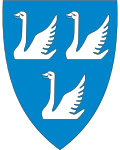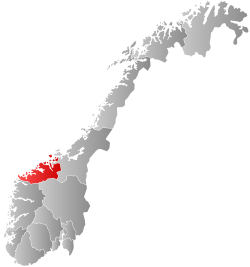Top Qs
Timeline
Chat
Perspective
Eide Municipality
Former municipality in Møre og Romsdal, Norway From Wikipedia, the free encyclopedia
Remove ads
Eide is a former municipality in Møre og Romsdal county, Norway. The 152-square-kilometre (59 sq mi) municipality existed from 1897 until its dissolution in 2020. The area is now part of Hustadvika Municipality in the traditional district of Romsdal. It was located on the Romsdal peninsula, along the Kornstadfjorden and the Kvernesfjorden. The administrative centre of the municipality was the village of Eide. Other villages included Lyngstad, Vevang, and Visnes.
The municipality was known for its traditional and modern limestone (marble) quarries and related crafts industry. The Atlanterhavsveien coastal road connected Eide Municipality to neighboring Averøy Municipality to the east. The municipal border was located at the Storseisundet Bridge on the Atlanterhavsveien road.
Prior to its dissolution in 2020, the 152-square-kilometre (59 sq mi) municipality was the 353rd largest by area out of the 422 municipalities in Norway. Eide Municipality was the 248th most populous municipality in Norway with a population of about 3,433. The municipality's population density was 22.6 inhabitants per square kilometre (59/sq mi) and its population had increased by 3.5% over the previous 10-year period.[5][6]
Remove ads
General information
Summarize
Perspective



The municipality of Eide was established on 1 January 1897 when the large Kvernes Municipality was divided into four municipalities: Eide Municipality (population: 1,552) in the west, Kornstad Municipality (population: 1,599) in the center, Bremsnes Municipality (population: 2,917) in the northeast, and Kvernes Municipality (population: 857) in the southeast.[7]
During the 1960s, there were many municipal mergers across Norway due to the work of the Schei Committee. On 1 January 1964, the Vevang area (population: 562) was transferred from Kornstad Municipality to Eide Municipality. On 1 January 1983, the uninhabited island of Eldhusøya (now part of the Atlanterhavsveien road) was transferred from Eide Municipality to Averøy Municipality.[7]
On 1 January 2020, Eide Municipality and Fræna Municipality were merged to form the newly-created Hustadvika Municipality.[8][9]
Name
The municipality (originally the parish) is named after the old Eide farm (Old Norse: Eið) since the first Eide Church was built there. The name comes from the dative case of the word eið which means "isthmus". This name is not referring to a true isthmus, but rather referring to a small valley area between two large hills and between the fjord and a large lake where the main village of Eide is located.[10]
Coat of arms
The coat of arms was granted on 9 July 1982. The official blazon is "Azure, three swans argent naiant wings displayed, 2 over 1" (Norwegian: I blått tre svømmende sølv svaner, to over en). This means the arms have a blue field (background) and the charge is three whooper swans (Cygnus cygnus). The swans have a tincture of argent which means they are commonly colored white, but if the arms are made out of metal, then silver is used. The swans are facing dexter in a swimming position. The swans were chosen since they are very common in the many local lakes. Each swan has seven feathers, representing the seven main villages in the municipality. The arms were designed by Jarle Skuseth. The municipal flag has the same design as the coat of arms.[11][12][13]
Churches
The Church of Norway had one parish (sokn) within Eide Municipality. It was part of the Ytre Nordmøre prosti (deanery) in the Diocese of Møre.
Remove ads
Geography
The municipality was located on the northern part of the Romsdal Peninsula, just west of the island of Averøya. Kvitholmen Lighthouse was located just off the northern coast of the municipality, in an area with hundreds of small islands and skerries. Fræna Municipality was located to the west, Gjemnes Municipality was to the southeast, and Averøy Municipality was to the east. The open Norwegian Sea was to the north. The highest point in the municipality was the 1,026.5-metre (3,368 ft) tall mountain Snøtinden.[1]
Remove ads
Government
Summarize
Perspective
While it existed, Eide Municipality was responsible for primary education (through 10th grade), outpatient health services, senior citizen services, welfare and other social services, zoning, economic development, and municipal roads and utilities. The municipality was governed by a municipal council of directly elected representatives. The mayor was indirectly elected by a vote of the municipal council.[14] The municipality was under the jurisdiction of the Frostating Court of Appeal.
Municipal council
The municipal council (Kommunestyre) of Eide was made up of 21 representatives that were elected to four year terms. The tables below show the historical composition of the council by political party.
Mayors
The mayor (Norwegian: ordfører) of Eide was the political leader of the municipality and the chairperson of the municipal council. The following people have held this position:[32]
- 1897–1898: O.M. Sildnes[33]
- 1899–1910: Ole P. Silseth[33]
- 1911–1919: Aslak Øyen[33]
- 1920–1925: Aslak J. Halås[33]
- 1926–1937: Edvard Brandshaug[33]
- 1938–1939: Birger Bergem[33]
- 1940–1951: Iver Dyrhaug[33]
- 1952–1953: Trygve E. Eide (V)[34]
- 1953–1960: Harald Øyen (H)[35]
- 1961–1975: Trygve Sildnes (Sp)[36]
- 1975–1975: Ole Herskedal (KrF)[37]
- 1976–1980: Johannes J. Vaag (Sp)[38]
- 1980–1981: Knut K. Strand (KrF)[39]
- 1982–1983: Paul Husøy (Ap)[39]
- 1984–1985: Ola Krogstad (Sp)[40]
- 1986–1995: Jon Skarvøy (Ap)[40]
- 1995–2003: Oddbjørn Silseth (H)[41]
- 2003–2011: Arnfinn Storvik (H)
- 2011–2015: Ove Silseth (H)
- 2015–2019: Egil Karstein Strand (H)
Remove ads
See also
References
Wikiwand - on
Seamless Wikipedia browsing. On steroids.
Remove ads





